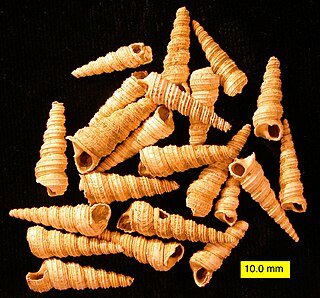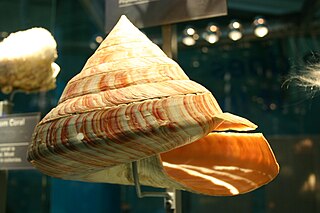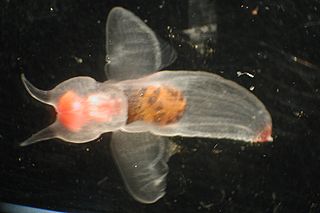 W
WApogastropoda was previously used as a major taxonomic grouping of sea snails, marine gastropod molluscs. This infraclass mostly consisted of marine limpets and operculate snails. At least 20,000 species were considered to exist within the two clades that were included, Heterobranchia and Caenogastropoda.
 W
WArchaeogastropoda was a taxonomic order of sea snails used in older classifications of gastropods, i.e. snails and slugs. Archeogastropoda are marine prosobranch gastropod mollusks, mainly herbivores, typically having two gills and a double-chambered heart, with the eggs and sperm discharged directly into the water. They were traditionally regarded as a relatively primitive group.
 W
WBasommatophora was a term that was previously used as a taxonomic informal group, a group of snails within the informal group Pulmonata, the air-breathing slugs and snails. According to the taxonomy of the Gastropoda, whenever monophyly has not been tested, or where a traditional taxon of gastropods has now been discovered to be paraphyletic or polyphyletic, the term "group" or "informal group" was used.
 W
WThe Cerithiimorpha was a suborder of marine gastropods within the Sorbeoconcha. This taxon is no longer valid according to the current taxonomy of Bouchet and Rocroi.
 W
WThe Euomphalina comprise a major suborder of mainly Paleozoic archaeogastropods, shells of which are hyperstophic to depressed orthstrophic, commonly with an angulation at the outer upper whorl surface thought to be coincident with the exhalent channel; shell wall thick, outer layer calcitic, inner layers aragonitic but not nacreous; operculum calcareous and heavy. Their range is from the Upper Cambrian to the Triassic, and possibly as high as the Upper Cretaceous.
 W
WMetarminoidea is a provisional taxonomic superfamily of colourful sea slugs, aeolid nudibranchs, marine opisthobranch gastropod molluscs in the clade Nudibranchia.
 W
WThe Neotaenioglossa is a taxonomic name for a large group of mostly sea snails. The name was originally created by Haller in 1882. Ponder and Warén (1988), and Marquet (1997), assigned this name to the superorder Caenogastropoda. ITIS considers the order Neotaenioglossa to be a synonym of Cerithioidea Férussac, 1819 .
 W
WNotaspidea, also known as the sidegill slugs, is an artificial grouping of sea slugs which is now split into two unrelated groups, the Umbraculida and the Pleurobranchomorpha.
 W
WOpisthobranchs is now an informal name for a large and diverse group of specialized complex gastropods which used to be united in the subclass Opisthobranchia. That taxon is no longer considered to represent a monophyletic grouping.
 W
WPleurotomariacea is one of two names that are used for a taxonomic superfamily of sea snails that are an ancient lineage and are well represented in the fossil record. The name Pleurotomariacea is used by paleontologists, who, because they usually have only the hard parts of mollusks to study, often use a slightly different scheme of classification from that used by scientists who study living mollusks.
 W
WProsobranchia was a large taxonomic subclass of sea snails, land snails and freshwater snails. This taxon of gastropods dates back to the 1920s. It has however been proven to be polyphyletic. Generally speaking in biology taxonomy is required to reflect phylogeny, in other words the classification of a group must reflect its evolutionary descent, as far as that is known, so the taxon Prosobranchia is no longer considered suitable to be used.
 W
WPteropoda are specialized free-swimming pelagic sea snails and sea slugs, marine opisthobranch gastropods. Most live in top 10 m of the ocean and are less than 1 cm long. The monophyly of Pteropoda is the subject of a lengthy debate; they have even been considered as paraphyletic with respect to cephalopods. Current consensus, guided by molecular studies, leans towards interpreting the group as monophyletic.
 W
WPulmonata, or "pulmonates", is an informal group of snails and slugs characterized by the ability to breathe air, by virtue of having a pallial lung instead of a gill, or gills. The group includes many land and freshwater families, and several marine families.
 W
WAccording to the taxonomy of Bouchet & Rocroi (2005), Strubellioidea was a taxonomic superfamily of sea slugs, mostly marine gastropod mollusks within the informal group Opisthobranchia.
 W
WTurbinoidea was a superfamily of small to large sea snails, marine gastropod mollusks in the clade Vetigastropoda. But it has become an available name, because it is no longer used in the current taxonomy of gastropods sensu Williams et al. (2008).